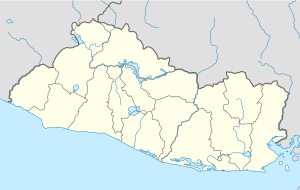Tehuacan (El Salvador)
| Tehuacan | ||
|---|---|---|
|
Coordinates: 13 ° 39 ′ N , 88 ° 48 ′ W Tehuacán on the map of El Salvador
|
||
| Basic data | ||
| Country | El Salvador | |
| Department | San Vicente | |
| Detailed data | ||
| height | 460 m | |
| Waters | Río Accihuapa | |
| Time zone | UTC −6 | |
Tehuacán is an archaeological site in the department of San Vicente in El Salvador .
It is located 10 kilometers southeast of Ciudad San Vicente . About half a kilometer from the road that connects San Vicente with Tecoluca , on the eastern slope of Chichontepec . It is located 469 meters above sea level on the site of the former Hacienda de Opico . The terrain slopes slightly to the south.
In Nahuat , Tehuacan means city made of stones. The ruins cover an area of about 3 square kilometers and the ceremonial center was about 1.5 square kilometers and is known as El Valle del León de Piedra (Valley of the Stone Lion) because a stone sculpture of a puma was found here. The Canton is now called León de Piedra . It is bordered by the Río Frío in the north, by the Barranca la Cayetana gorge in the south, the Quebrada Honda brook in the west and by the settlement of the manor house of the Hacienda Opico in the east. The site consists of leveled rectangular areas, the long sides run from north to south, stairs, which are separated by 10 or 12 low stone and rammed earth walls, which are known as fortresses. These give the ensemble the impression of immeasurable expansion. The planes connect ramps. In the center there is a well-aligned main plane which is enclosed by hewn stones. The locals call these traces La iglesia (The Church), they measure 60 meters in north-south direction and 35 meters in east-west direction. The operation of a cemetery in the León de Piedra settlement has partially replaced the traces with younger ones. In the south is the great pyramid of Tehuacán, whose base sides measure 65 meters in west-east direction and 40 meters in north-south direction. It consists of rammed earth and hewn stones and is about 20 meters high. There are many mounds or barrows in their vicinity.
Investigations
In 1882, the two French artillery officers , the seismologist Conde Fernando de Montessus de Ballore and the military adviser Joseph Albert Touflet, wanted to examine the ruins, but had to refrain from doing so because the indigenous people of the village of Tecoluca would not let them into their territory. John William Dawson noted in his Geografía Elemental de la República del Salvador (París, 1890, p.54) that northeast of Tecoluca there are important ruins of the ancient city of Tehuacán, which would be worthy of study and protection as historical memories. In April 1892 the ruins of the site were opened by Dr. Darío Gonzáles examines. He was taken over by the owner of the Hacienda Opico Dr. Nicolás Angulo supported who cleared trees and bushes.
Individual evidence
- ^ Prensa Libre , 21 de noviembre de 2007, Fernando de Montessus de Ballore
- ↑ cesarramirezcaralva , Capitán Joseph Albert Touflet, amistad Francia El Salvador
- ↑ Municipality of Tecoluca , Tehuacan ( Memento of 14 October 2007 at the Internet Archive )
